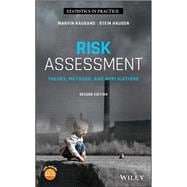Introduces risk assessment with key theories, proven methods, and state-of-the-art applications
Risk Assessment: Theory, Methods, and Applications remains one of the few textbooks to address current risk analysis and risk assessment with an emphasis on the possibility of sudden, major accidents across various areas of practice—from machinery and manufacturing processes to nuclear power plants and transportation systems. Updated to align with ISO 31000 and other amended standards, this all-new 2nd Edition discusses the main ideas and techniques for assessing risk today.
The book begins with an introduction of risk analysis, assessment, and management, and includes a new section on the history of risk analysis. It covers hazards and threats, how to measure and evaluate risk, and risk management. It also adds new sections on risk governance and risk-informed decision making; combining accident theories and criteria for evaluating data sources; and subjective probabilities. The risk assessment process is covered, as are how to establish context; planning and preparing; and identification, analysis, and evaluation of risk. Risk Assessment also offers new coverage of safe job analysis and semi-quantitative methods, and it discusses barrier management and HRA methods for offshore application. Finally, it looks at dynamic risk analysis, security and life-cycle use of risk.
- Serves as a practical and modern guide to the current applications of risk analysis and assessment, supports key standards, and supplements legislation related to risk analysis
- Updated and revised to align with ISO 31000 Risk Management and other new standards and includes new chapters on security, dynamic risk analysis, as well as life-cycle use of risk analysis
- Provides in-depth coverage on hazard identification, methodologically outlining the steps for use of checklists, conducting preliminary hazard analysis, and job safety analysis
- Presents new coverage on the history of risk analysis, criteria for evaluating data sources, risk-informed decision making, subjective probabilities, semi-quantitative methods, and barrier management
- Contains more applications and examples, new and revised problems throughout, and detailed appendices that outline key terms and acronyms
- Supplemented with a book companion website containing Solutions to problems, presentation material and an Instructor Manual
Risk Assessment: Theory, Methods, and Applications, Second Edition is ideal for courses on risk analysis/risk assessment and systems engineering at the upper-undergraduate and graduate levels. It is also an excellent reference and resource for engineers, researchers, consultants, and practitioners who carry out risk assessment techniques in their everyday work.








